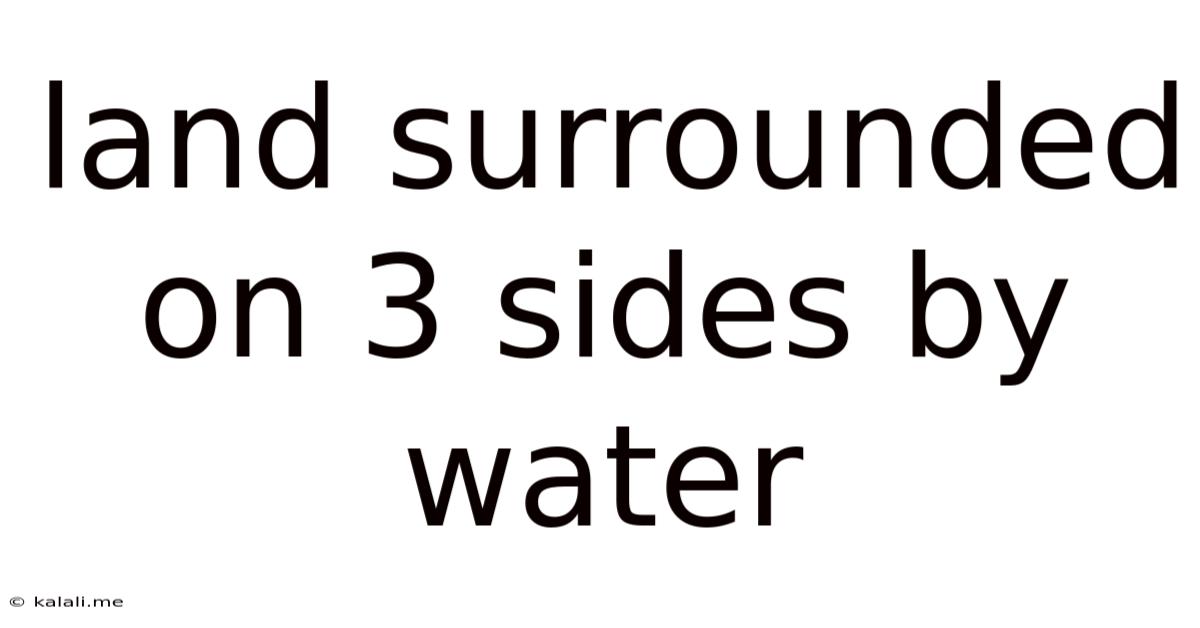Land Surrounded On 3 Sides By Water
Kalali
Jun 12, 2025 · 3 min read

Table of Contents
Land Surrounded on 3 Sides by Water: Understanding the Terminology and Geography
A piece of land surrounded by water on three sides is commonly referred to as a peninsula. This geographic feature is a prominent landform found across the globe, showcasing a diverse range of ecosystems and human settlements. This article will delve into the definition, formation, characteristics, and examples of peninsulas, clarifying any confusion surrounding similar terms.
What exactly is a peninsula? A peninsula is a landmass projecting into a body of water and is connected to a larger landmass by an isthmus—a narrow strip of land. The crucial element defining a peninsula is its three-sided water enclosure, creating a distinct geographical entity. This can range from small, secluded headlands to massive landmasses encompassing vast territories.
Formation of Peninsulas: A Look at Geological Processes
The creation of peninsulas is a complex process driven by a variety of geological forces. These include:
- Tectonic Plate Movement: The movement and collision of tectonic plates can uplift sections of the seabed, creating new landmasses that eventually become peninsulas. This often results in mountainous peninsulas.
- Erosion and Deposition: The relentless action of wind, water, and ice can erode coastlines, leaving behind protruding landforms. Conversely, the deposition of sediments can also build up land extending into the water.
- Volcanic Activity: Volcanic eruptions can create new land, sometimes forming peninsulas as lava flows cool and solidify.
- Glacial Activity: The movement and melting of glaciers can carve out valleys and channels, shaping coastlines and contributing to the formation of peninsulas.
These processes often work in combination, creating a unique geological history for each peninsula.
Distinguishing Peninsulas from Other Landforms: Avoiding Confusion
It's important to differentiate a peninsula from similar landforms:
- Island: An island is completely surrounded by water. This is the key difference; a peninsula maintains a connection to a larger landmass.
- Cape: A cape is a point of land that extends into the sea, often smaller and less substantial than a peninsula.
- Promontory: A promontory is a high point of land that juts out into the water; similar to a cape but can be larger.
Examples of Famous Peninsulas Worldwide: A Global Perspective
The world boasts many stunning examples of peninsulas, each with its unique characteristics and significance:
- The Iberian Peninsula (Spain and Portugal): A large peninsula in Southwestern Europe, home to diverse cultures and landscapes.
- The Italian Peninsula: Famous for its boot-shaped outline and rich history.
- The Arabian Peninsula: One of the largest peninsulas in the world, encompassing several countries in the Middle East.
- The Korean Peninsula: A strategically important peninsula in East Asia.
- Florida Peninsula (United States): A popular tourist destination known for its beaches and warm climate.
The Importance of Peninsulas: Ecological and Human Significance
Peninsulas play a crucial role in both ecology and human society:
- Biodiversity Hotspots: The unique geographical position of peninsulas often leads to high levels of biodiversity, with distinct plant and animal species adapted to coastal environments.
- Strategic Locations: Their location makes peninsulas strategically important for trade, defense, and resource extraction.
- Human Settlements: Many significant cities and settlements have developed on peninsulas throughout history, taking advantage of coastal resources and access to trade routes.
In conclusion, the term "land surrounded on 3 sides by water" accurately describes a peninsula, a significant landform shaped by complex geological processes. Understanding its formation, characteristics, and differentiation from other landforms provides a clearer appreciation of its importance in geography, ecology, and human history.
Latest Posts
Latest Posts
-
5 X 5 X 5 X 5
Jul 01, 2025
-
How Many Cups In A 5th Of Vodka
Jul 01, 2025
-
How Much Is 20 Lbs Of Pennies Worth
Jul 01, 2025
-
How Much Is 20 Lb Of Pennies Worth
Jul 01, 2025
-
How Many 12 Oz Cans In A 2 Liter
Jul 01, 2025
Related Post
Thank you for visiting our website which covers about Land Surrounded On 3 Sides By Water . We hope the information provided has been useful to you. Feel free to contact us if you have any questions or need further assistance. See you next time and don't miss to bookmark.